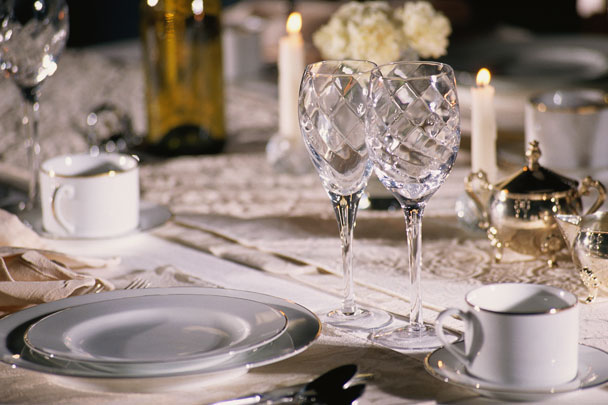On January 24, 1981, my mother had a dinner party. She served mushrooms Berkeley, Creole bouillabaisse, a green salad and pear and ginger pie. She used her white plates—Arzberg Athena, a wedding gift from my grandparents—and a yellow Marimekko cloth probably bought at Design Research. On April 19, 1987 she also had a dinner party. She served cantaloupe soup, poached rainbow trout and strawberries with sour cream. The plates were Della Robbia and the centerpiece was hand-dyed Easter eggs.
How do I know this? My mother has kept a notebook of every dinner party she has hosted since 1979: menu, guests, cloths and flowers, and typically notes on recipes and sources. Those mushrooms were from the Vegetarian Epicure, newly popular in Cambridge circles. Previous years she relied heavily on Ada Boni’s Italian Regional Cooking, plus James Beard, the New York Times Cookbook, and Cooking for Crowds by local Merry White. Her notebook meant no one would be served Creole bouillabaisse twice at our house. That (once we moved to Durham) the political scientists from Duke might meet some political scientists from UNC, or some neighbors from down the block.
In the 1970s and 1980s dinner parties were how my parents socialized. Selected, mixed and remixed groups of six to eight. They came to our house at 7. My mother wore perfume and lipstick (not an everyday occurrence). My father offered drinks to start and did the dishes at the end. My brother and I were allowed to pass the hors d’oeuvres and eat a specific number of pita triangles dipped in hummus or babaganoush before being sent upstairs to bed. (Now my son eats Trader Joe’s edamame hummus out of the container with a spoon, but back then hummus was exotic and entirely homemade. Edamame: then called soy beans and grown locally in North Carolina.) We hosted a dinner every month or two, and my parents went out to one at someone else’s house almost every other Saturday night.
My mouth waters when I read my mother’s notebook. Saltimbocca. Lamb tagine with apricots. Pollo al Jerez. Italian cornmeal cake and my Omi’s plum tart for dessert, caponata or caviar toasts to start. I have white china in my cabinet, an orange Marimekko tablecloth in a drawer, the New York Times Cookbook and the Silver Palate and the Silver Spoon on the shelf. I could have a dinner party. And yet I don’t. And none of my friends do either.
I don’t think I have ever been invited to a meal at someone’s house where the table was laid with china, tablecloth and flowers, the hosts dressed up, the food prepared, the guest list a balance of new people and old friends. Lest I never receive another invitation again: I am not ungrateful. Yes, we gather around the coffee table and in the kitchen in groups of ten and up. We brunch with another couple and hope the children won’t fight. It is fun and you do have a few minutes to catch up. But I know I have served the same people the same quiche more than once. I’m always wearing the same thing as my three-year-old. Paper napkins from IKEA are fine, right?
The dream of the dinner party, in my mind, is the reciprocity of effort: care has been taken by the host to get the food and the people and the mood right, and care has been taken by the guest to be on time and accessorized and without children. We could talk in peace, drink as much wine as we want and, maybe, relax. Those that we invite would invite us back. We’d make new friends. The ambitiousness of cuisine in Julie & Julia used to be universal (among a certain set), and now it is worthy of blog, book, rom-com. But I’m equally intrigued in the ambitiousness of the social life—as distinct from social climbing.
So what happened to the dinner party? (And I’m told, in certain redoubts like Princeton, baby boomers are still having them.) Short answer: time, space, skills. We work more hours, and a Saturday spent cooking just seems like more work, particularly if there is (as there often was at my parents’ parties) a professional agenda to some or all of the invitations. I just went to a fun, tasty Christmas party for which the host had cooked nothing. Costco, IKEA and the local gourmet shop supplied all. No one had to spend all day cooking while their spouse took the kids out, though my mother speaks fondly of pounding, slicing, whisking and listening to opera on NPR. She can’t remember where we were.



 Pinterest
Pinterest


